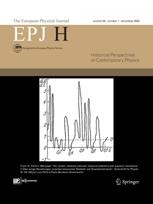Acknowledging Fermi’s contributions to early quantum statistics
Enrico Fermi’s ideas played a key role in the origins of quantum statistics, but so far, they have been largely overlooked in historical analysis
New York | Heidelberg, 18 March 2022
 Within large systems of identical fermions, Fermi-Dirac statistics describes how identical fermions may never occupy the same quantum state. First introduced by Italian physicist, Enrico Fermi, this concept was a key step in our early understanding of quantum mechanics – yet so far, Fermi’s contributions have been largely overlooked in historical analysis. Through new research published in EPJ H, Enric Pérez and Joana Ibáñez, both at the University of Barcelona, Spain, offer a critical analysis of Fermi’s ideas, and assess their immediate impact on our early conceptions of quantum mechanics.
Within large systems of identical fermions, Fermi-Dirac statistics describes how identical fermions may never occupy the same quantum state. First introduced by Italian physicist, Enrico Fermi, this concept was a key step in our early understanding of quantum mechanics – yet so far, Fermi’s contributions have been largely overlooked in historical analysis. Through new research published in EPJ H, Enric Pérez and Joana Ibáñez, both at the University of Barcelona, Spain, offer a critical analysis of Fermi’s ideas, and assess their immediate impact on our early conceptions of quantum mechanics.
Fermi-Dirac statistics is centred on the concept of quantum particles which can’t be distinguished from each other. This idea also forms the basis of Bose-Einstein statistics: which in contrast, describes how identical bosons may aggregate in the same quantum state. Yet despite the clear relevance of Fermi’s ideas at the time, Pérez and Ibáñez argue that the influence of Bose-Einstein has been far more widely discussed so far.
Through their analysis of the 1926 paper where Fermi introduced his ideas, the duo found that he largely isolated himself from the vibrant physics community of the time, and developed his ideas largely independently. Notably, he didn’t seem to care about Einstein’s efforts to explain the aggregation of bosons into single states – which stood in contrast to his own ideas.
Pérez and Ibáñez also consider the early applications of Fermi-Dirac statistics. In the years following Fermi’s paper, it was used by a variety of prominent physicists to study effects including the heat capacity of room-temperature metals, and the luminosities of stars. Yet the duo also found that applications of Fermi-Dirac statistics remained largely practical in these cases, and that physicists placed little focus on interpreting the theories underlying their observations. Altogether, Pérez and Ibáñez hope that these insights will fill a gap in our understanding of how quantum statistics originated.
References: E Pérez, J Ibáñez, Indistinguishable elements in the origins of quantum statistics. The case of Fermi-Dirac statistics EPJ H 47, 1 (2022). https://doi.org/10.1140/epjh/s13129-021-00033-6
Further Information
For more information visit: www.epj.org
Services for Journalists
The full-text articles are available here.
Contact
Sabine Lehr | Springer | Physics Editorial Department
tel +49-6221-487-8336 | sabine.lehr@springer.com
